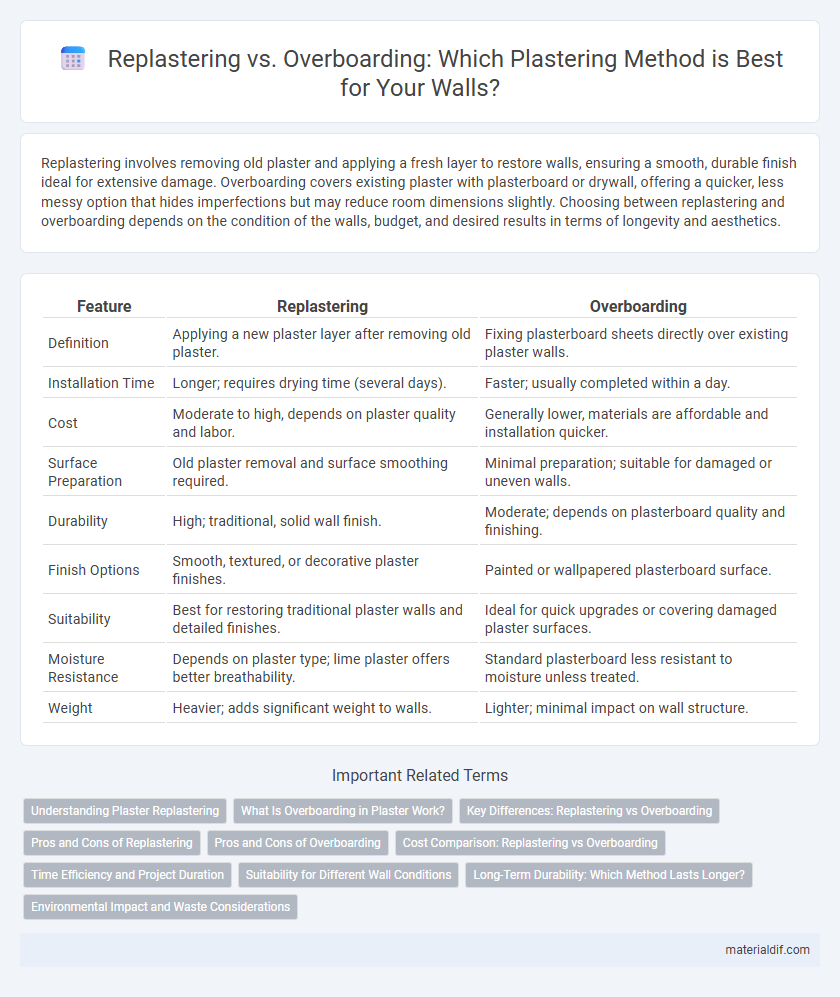Replastering involves removing old plaster and applying a fresh layer to restore walls, ensuring a smooth, durable finish ideal for extensive damage. Overboarding covers existing plaster with plasterboard or drywall, offering a quicker, less messy option that hides imperfections but may reduce room dimensions slightly. Choosing between replastering and overboarding depends on the condition of the walls, budget, and desired results in terms of longevity and aesthetics.
Table of Comparison
| Feature | Replastering | Overboarding |
|---|---|---|
| Definition | Applying a new plaster layer after removing old plaster. | Fixing plasterboard sheets directly over existing plaster walls. |
| Installation Time | Longer; requires drying time (several days). | Faster; usually completed within a day. |
| Cost | Moderate to high, depends on plaster quality and labor. | Generally lower, materials are affordable and installation quicker. |
| Surface Preparation | Old plaster removal and surface smoothing required. | Minimal preparation; suitable for damaged or uneven walls. |
| Durability | High; traditional, solid wall finish. | Moderate; depends on plasterboard quality and finishing. |
| Finish Options | Smooth, textured, or decorative plaster finishes. | Painted or wallpapered plasterboard surface. |
| Suitability | Best for restoring traditional plaster walls and detailed finishes. | Ideal for quick upgrades or covering damaged plaster surfaces. |
| Moisture Resistance | Depends on plaster type; lime plaster offers better breathability. | Standard plasterboard less resistant to moisture unless treated. |
| Weight | Heavier; adds significant weight to walls. | Lighter; minimal impact on wall structure. |
Understanding Plaster Replastering
Plaster replastering involves removing damaged or old plaster layers before applying a fresh coat, ensuring better adhesion and a smoother finish. This process addresses underlying issues such as cracks, dampness, or uneven surfaces, restoring wall integrity and appearance. Unlike overboarding, which involves fixing plasterboard over existing plaster, replastering maintains the original wall's breathability and historical character.
What Is Overboarding in Plaster Work?
Overboarding in plaster work involves fixing new plasterboard directly over existing walls to create a smooth, even surface without removing old plaster. This method saves time and labor costs compared to replastering, which requires scraping off old plaster before applying a fresh coat. Overboarding is ideal for walls with minor imperfections and can improve insulation and soundproofing when combined with appropriate plasterboard types.
Key Differences: Replastering vs Overboarding
Replastering involves removing the old plaster and applying a fresh layer, providing a traditional, smooth finish that restores wall integrity and durability. Overboarding installs drywall or plasterboard directly over existing plaster, speeding up renovation and improving insulation but potentially increasing wall thickness. The key differences lie in cost, preparation time, and the final surface texture, with replastering favored for authenticity and overboarding for convenience.
Pros and Cons of Replastering
Replastering restores wall surfaces by removing old plaster and applying a fresh layer, enhancing durability and allowing repair of cracks or damaged areas. It ensures a uniform finish compatible with traditional backgrounds and improves wall insulation but can be time-consuming and messy compared to overboarding. Costs may be higher due to labor and drying time, yet replastering preserves wall breathability, reducing moisture buildup and potential mold problems.
Pros and Cons of Overboarding
Overboarding offers a quicker and less labor-intensive alternative to replastering by covering existing walls with plasterboard, reducing dust and mess during installation. It provides an opportunity to add insulation or soundproofing layers but can reduce room dimensions and may not address underlying structural or damp issues. While overboarding is cost-effective for cosmetic updates, replastering remains superior for restoring damaged or uneven surfaces to a smooth, durable finish.
Cost Comparison: Replastering vs Overboarding
Replastering involves removing old plaster and applying a new layer, typically costing between $3 to $8 per square foot depending on labor and material quality. Overboarding uses plasterboard sheets fixed over existing walls, averaging $2 to $5 per square foot, offering a quicker and often more affordable solution. Budget considerations should include surface preparation, material durability, and labor time when comparing replastering and overboarding costs.
Time Efficiency and Project Duration
Replastering typically requires more time due to surface preparation, drying, and curing processes, which can extend the overall project duration significantly. Overboarding offers a faster alternative by simply fixing plasterboards directly over existing walls, reducing labor and eliminating drying time. For projects with tight deadlines, overboarding enhances time efficiency and speeds up completion without compromising wall surface quality.
Suitability for Different Wall Conditions
Replastering is ideal for walls with significant damage, uneven surfaces, or deteriorating plaster, providing a strong, durable base by removing old layers. Overboarding suits stable walls with minor imperfections, offering a quicker solution by fixing plasterboard directly over existing plaster, which enhances surface smoothness without extensive preparation. Assessing wall stability and damage severity determines whether replastering or overboarding ensures optimal finish and longevity.
Long-Term Durability: Which Method Lasts Longer?
Replastering typically offers superior long-term durability by restoring the wall's original surface with new plaster layers that bond deeply, preventing cracks and moisture damage. Overboarding involves fixing new boards over existing plaster, providing a quicker solution but with less structural integrity and potential for future movement or deterioration. For lasting strength and resilience, replastering is generally the recommended method over overboarding.
Environmental Impact and Waste Considerations
Replastering generates less construction waste compared to overboarding, reducing landfill burden and lowering carbon emissions associated with material disposal. Overboarding typically involves installing plasterboard over existing plaster, increasing material usage and contributing to higher embodied energy. Choosing replastering supports sustainable building practices by minimizing resource consumption and promoting the reuse of existing surfaces.
Replastering vs Overboarding Infographic

 materialdif.com
materialdif.com